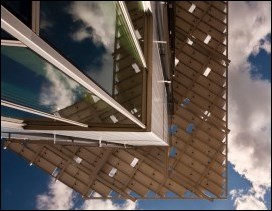by Brianna Crandall — January 20, 2014—World Architecture News (WAN) recently named The Bullit Center in Seattle, Washington, as the WAN Sustainable Building of the Year 2013. The structure beat out five global finalists in a rigorous selection process, and was cited by judges for meeting all net annual energy needs with onsite renewable energy sources.
According to WAN, each shortlisted entry tackled the challenge of sustainability in a different way, creatively solving specific problems in their varying sectors, ranging from education to commercial to healthcare. Challenges faced ranged from saving energy in a hospital in Norway to a desert learning center in the United Arab Emirates facing extreme exposure and temperatures tackling water consumption.
The Bullit Center by The Miller Hull Partnership was built in Seattle, Washington, and initiated by Earth Day co-founder Denis Hayes, with sustainability reportedly driving the design process from the beginning. WAN says that the net zero energy project is a “shining example” of sustainable building for the future, and of designing to make the lowest impact.
According to WAN, the Bullit Center is the first leasable market-rate commercial structure to earn Net Zero Energy Building Certification through the Living Building Challenge, including adhering to the omission of all toxic chemicals that appear on the prohibited “red list.” The building’s overhanging photovoltaic rooftop and façade provide the energy for the entire building by supplying 230,000 kilowatt hours per year. The overall energy usage is roughly 20 percent of the other buildings of its type in Seattle, adds WAN.

The judges also praised the building’s aesthetic design, an important part of the finished project since it is a leasable building. Using materials locally sourced from a renewable supply, as stipulated in the Living Building Challenge, the finished project features an “irresistible stair” rather than an elevator, operable floor-to-ceiling windows, and heavy timber framing throughout.
The judges felt that the project looked creatively at sustainable building in the context of its environment of the city of Seattle, taking into consideration the local climate and the materials of that area. They also commended the “deep commitment and collaboration from client, public agencies, and full multidisciplinary design team to making important new discoveries for sustainable design.”





